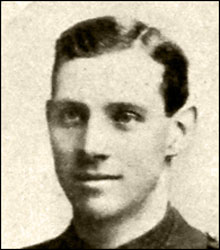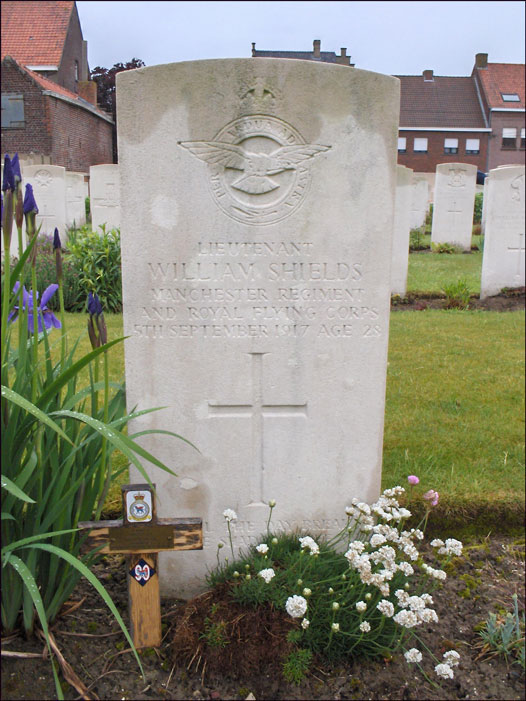![]() In memoriam
In memoriam ![]()
Lieutenant William Shields

William Shields was born on 31 January 1889 at Seaforde, Downpatrick, County Down, son of servant and coachman Samuel Shields and his wife Sarah (nee McNeill).
Educated at Queen's University, Belfast, where he served in the Officer Training Corps, Shields was later employed as a National School teacher. At the outbreak of the war he was teaching at Skegoneil School in Belfast.
Shields enlisted in the North Irish Horse at Belfast on 18 February 1915 (No.1450). He immediately applied for a commission and was made a 2nd lieutenant in the infantry on 21 March (with seniority from 2 March). He was posted to the Manchester Regiment. On 1 October 1915 he was promoted to the rank of lieutenant.
Early in 1916 Shields embarked for Egypt where he joined a battalion of the Manchester Regiment. At some stage he returned to England and was posted to the 14th (Reserve) Battalion of the regiment.
On 17 April 1917 he was attached to the Royal Flying Corps as a flying officer and underwent a period of training. On 22 August he was posted to No.45 Squadron in France.
At 7.10 am on 5 September he took off on an offensive patrol, flying a Sopwith Camel. He attacked an enemy aircraft but was shot down by another, crashing near the British lines in no man's land, close to Comines.
Shields' body was recovered and he was buried at Voormezeele Enclosures No.1 and No.2, Ieper, West-Vlaanderen, Belgium, grave I.H.41. The gravestone inscription reads:
LIEUTENANT
WILLIAM SHIELDS
MANCHESTER REGIMENT
AND ROYAL FLYING CORPS
5TH SEPTEMBER 1917 AGE 28
UNTIL THE DAY BREAK
AND THE SHADOWS FLEE AWAY
The circumstances of his death were further described in the Belfast News-Letter of 25 September 1917:
HOW A BELFAST AIRMAN DIED.
Put Up "a Most Magnificent Fight."Details are now to hand regarding the circumstances under which Lieutenant William Shields, Manchester Regiment, attached Royal Flying Corps (formerly Skegoneil School, Belfast), was killed in action on the western front. The officer commanding deceased's squadron, in a letter to the bereaved father, Mr. Samuel Shields, 33, Upper Frank Street, Belfast, writes:– "Your son was killed in aerial combat. Eye-witnesses whom I have questioned inform me that your son put up a most magnificent fight. It appears that he was fighting a Hun 'plane, and would have shot it down, when another German 'plane, which your son couldn't see, dived down on his tail. Your son was killed instantaneously, as his machine fell completely out of control in front of our lines. His body was recovered, and buried behind the lines with military honours."
Another officer states:– "Your son was in my flight, and for that reason I feel I ought to tell you how much we all appreciated him. We all liked him. He was of the type that helps to make our work lighter. He was an amicable and pleasant comrade, a good pilot, and as a member of our mess he was very much appreciated. He was on patrol duty, and in diving on an enemy machine he was in turn attacked by another. Eye-witnesses from the ground said that he put up a magnificent fight, but the odds were overmuch. His machine fell, and he with it. He died, in the Big Job, a man's death."
Three of Lieutenant Shields' brothers also served in the war. Sergeant Samuel Shields of the 8th Battalion, Royal Irish Rifles, was awarded a Military Medal, and was killed in action on the Somme on 2 July 1916. Private Neil Shields served in the 14th Battalion, Royal Irish Rifles, before joining the Tank Corps. Private Robert Shields served in the Royal Flying Corps.
Image of gravestone kindly provided by Mick McCann, through his British War Graves website www.britishwargraves.co.uk. Image of Lieutenant Shields sourced from the South Dublin Library Service's Our Heroes site http://ourheroes.southdublinlibraries.ie/

